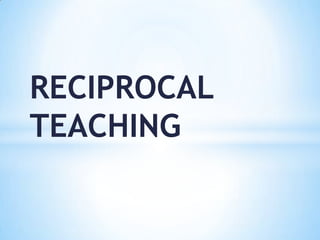
Reciprocal Teaching
- 2. *By Definition, Reciprocal Teaching is an instructional method that involves guided practice of reading comprehension using four concrete steps *The job of the teacher is to provide modeling, scaffolding, feedback, and cooperate in making efforts of understanding the material that is being taught.
- 3. 1. Paraphrasing 2. Reported Speech 3. Question Making 4. Concept checking 5. Summary 6. Prediction *
- 4. To state somebody’s words or ideas in your own words through the use of synonyms or equivalent phrases. In classroom we can use for Teacher’s instructions A classmate’s comment *
- 5. To change a direct statement, question or command into an indirect one. We can use it to: Report after pair work, group work, debates, discussions, etc. *
- 6. After teacher’s model, students are encouraged to make questions to each other. The degree of difficulty should vary according to the level. *
- 7. Students have to be aware of the implications of the lesson and understand the instructions they are given to complete a task. After giving and modeling instructions, the teacher can ask students to verbalize them. *
- 8. When having group discussions, students are to summarize the conclusions, main ideas and the most important features of the activity. It can also be used as a wrap up of the lesson. *
- 9. * Specially used in reading. Teacher can increase student interaction using the headlines, titles, subtitles, the pictures, etc.
- 10. Don’t be afraid to try R.T even with your basic classes. Make sure students understand the purpose of the technique. Make sure students know each other’s names. (name tags) Don’t give up if your first attempts are unsuccessful. Don’t try using R.T to impress observers if your students aren’t used to it. Useful R.T. tips
